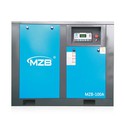As a reputable supplier of Screw Type Air Compressors, I've encountered numerous inquiries from customers regarding how to increase the air pressure of these essential machines. In this blog, I'll share some professional insights and practical methods to help you boost the air pressure of your screw type air compressor effectively.
Understanding the Basics of Screw Type Air Compressors
Before diving into the methods of increasing air pressure, it's crucial to have a basic understanding of how screw type air compressors work. A Screw Type Air Compressor operates by using two meshing helical screws, also known as rotors, to compress the air. As the rotors turn, air is drawn into the compressor and trapped between the rotors. The volume between the rotors decreases as they rotate, causing the air to be compressed.
The air pressure generated by a screw type air compressor depends on several factors, including the design of the compressor, the speed of the rotors, and the efficiency of the compression process. By understanding these factors, you can take appropriate steps to increase the air pressure output.
Methods to Increase Air Pressure
1. Adjust the Pressure Settings
One of the simplest ways to increase the air pressure of a screw type air compressor is to adjust the pressure settings. Most modern compressors come with a pressure switch that allows you to set the desired pressure range. By increasing the cut-out pressure, which is the maximum pressure at which the compressor stops, you can raise the overall air pressure output.
However, it's important to note that you should not exceed the maximum pressure rating of the compressor. Exceeding this limit can cause damage to the compressor and pose a safety risk. Always refer to the manufacturer's instructions when adjusting the pressure settings.
2. Check and Clean the Air Filters
Clogged air filters can restrict the airflow into the compressor, reducing its efficiency and air pressure output. Regularly checking and cleaning the air filters is essential to ensure optimal performance. Replace the filters if they are damaged or excessively dirty.
A clean air filter allows more air to enter the compressor, which can help increase the air pressure. Additionally, it can also extend the lifespan of the compressor by preventing dust and debris from entering the internal components.
3. Inspect and Maintain the Belts and Pulleys
If your screw type air compressor is belt-driven, the belts and pulleys play a crucial role in transferring power from the motor to the rotors. Loose or worn-out belts can cause slippage, resulting in a decrease in air pressure. Inspect the belts regularly and adjust the tension as needed. Replace any belts that show signs of wear or damage.
The pulleys should also be inspected for proper alignment. Misaligned pulleys can cause the belts to wear unevenly and reduce the efficiency of the compressor. Make sure the pulleys are clean and free from debris to ensure smooth operation.
4. Optimize the Cooling System
Overheating can cause the compressor to lose efficiency and reduce the air pressure output. The cooling system of the compressor, including the radiator and cooling fans, should be checked regularly to ensure proper operation. Clean the radiator fins to remove any dirt or debris that may be blocking the airflow.


If the compressor is located in a hot environment, consider installing additional cooling equipment or relocating the compressor to a cooler area. Maintaining the proper operating temperature of the compressor is essential for achieving maximum air pressure.
5. Upgrade the Compressor Components
In some cases, upgrading certain components of the compressor may be necessary to increase the air pressure. For example, you can consider upgrading the rotors to a larger size or a higher efficiency design. This can increase the compression ratio and result in a higher air pressure output.
However, upgrading the components should be done carefully and in consultation with a professional. Not all compressors are suitable for component upgrades, and improper upgrades can cause damage to the compressor.
Considerations for Different Applications
The methods of increasing air pressure may vary depending on the specific application of the screw type air compressor. For Industrial Use Screw Air Compressors, which are often used in high-demand applications, more advanced techniques may be required.
In industrial settings, it's important to ensure that the compressor is properly sized for the application. An undersized compressor may not be able to provide the required air pressure, while an oversized compressor can be inefficient and costly to operate.
For applications that require a constant and stable air pressure, such as in pneumatic tools or automated production lines, a pressure regulator can be installed downstream of the compressor. A pressure regulator allows you to maintain a consistent air pressure regardless of the fluctuations in the compressor's output.
Conclusion
Increasing the air pressure of a screw type air compressor requires a combination of proper maintenance, adjustment, and, in some cases, component upgrades. By following the methods outlined in this blog, you can improve the performance of your compressor and achieve the desired air pressure output.
As a supplier of Rotary Screw Air Compressors, we are committed to providing our customers with high-quality products and professional advice. If you have any questions or need further assistance in increasing the air pressure of your compressor, please don't hesitate to contact us. We are here to help you find the best solution for your specific needs. Whether you are looking to purchase a new compressor or need support for your existing one, our team of experts is ready to assist you in the procurement process. Let's work together to ensure your operations run smoothly with reliable and efficient air compression.
References
- Manufacturer's manuals for screw type air compressors
- Industry standards and guidelines for air compressor operation and maintenance
- Technical literature on air compression technology






